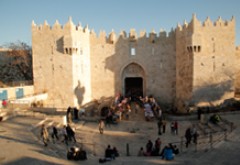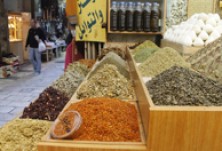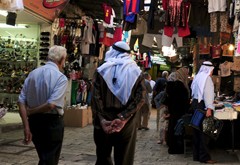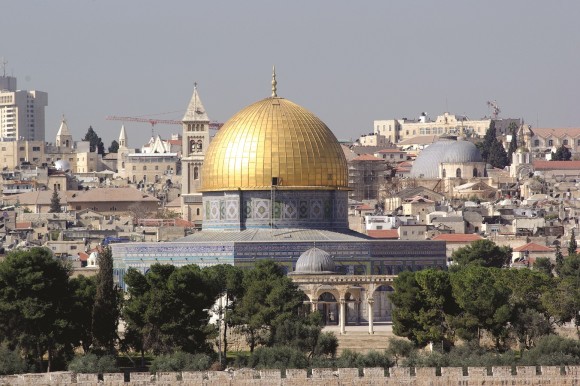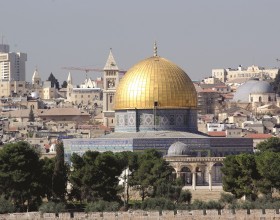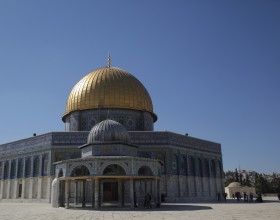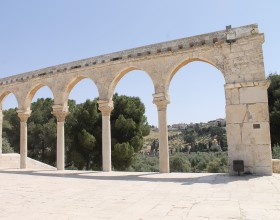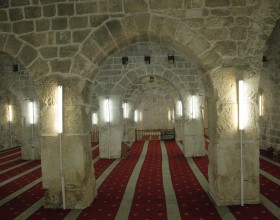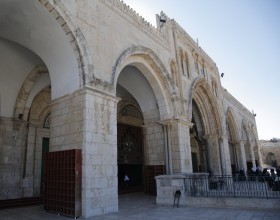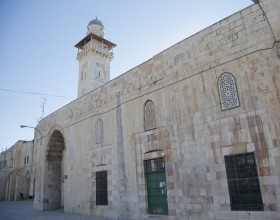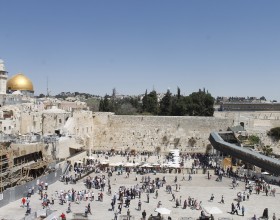Paths And Trails
Al-Isra and Al-Mi’raj
The miracle of Isra' and Mi'rajhasconnected Mecca and Jerusalem with a perpetual mutual holy bond, and transformed Jerusalem into a gateway to heaven, giving it an outstanding status in Islam. Based on this concept, the most important Islamic structures were built in this city.
Trail’s Nature and Stations
This trail is related to a particular part of the al-Aqsa Mosque, focusing on sites and locations associated with the Isra and Mi’raj, and of significance in Islam and Prophet Mohammad’s life, as well as in the architectural development of al-Aqsa Mosque. This trail is easy and enjoyable, and highly spiritual. If contemplation, prayer, and reading the Holy Quran are to be part of the trail, then it would require several hours to complete. The trail requires patience, quiet, piety, and a demure dress code. Like all the trails, the stations on this trail are mere suggestions, and the visitor will be able to visit other sites and locations in and around the area of al-Aqsa Mosque.
The trail begins in the center of the Dome of the Rock, believed by Muslims to be the spot from which Prophet Mohammad ascended to the heavens, and ends at the beginning of al-Sharaf neighborhood, which overlooks al-Buraq Wall (the Western Wall).
The trail is composed of the following stations:
1- Qubbat al-Sakhra (The Dome of the Rock)
2- Qubbat al-Silsilah (The Dome of the Chain)
3- The Eastern Colonnade
4- Al-Marwani Mosque
5- Old -Aqsa mosque
6- Al-Jami’ al-Aqsa (Friday pryaer mosque)
7- Islamic Museum
8- Al-Ashrafiyya School
9- Al-Buraq Wall (the Western Wall)
Introduction
Location and Borders of al-Aqsa Mosque
Al-Aqsa Mosque is located on a raised platform in the southeast part of the Old City of Jerusalem. The mosque sits on a trapezoidal platform bordered from the east by a wall, 462 meters long, which constitutes one of the mosque’s walls and part of the wall of the Old City of Jerusalem. This also applies to the southern wall that stretches for about 281 meters. As for the northern wall, 310 meters long, and the western wall, 491 meters long, they are formed from a group of buildings and schools that were built in the Ayyubid and Mamluk eras and were a foundation for architectural layers that came in later eras, particularly the Ottoman. This area is nearly 144 dunums, constituting around one seventh of the Old City of Jerusalem.
The Names of al-Aqsa Mosque
This area has been known by a variety of names, the most significant of which is al-Aqsa Mosque, a name that appeared in the Holy Quran (al-Isra, Verse 1). Although many prefer this naming, the more famous name was al-Haram al-Sharif (The Noble Sanctuary). This was probably to avoid any confusion between the covered al-Jami’ (mosque) al-Aqsa, where the imam delivered the Friday sermons and which is located in the center of the southern part of the area, and al-Aqsa Mosque, which refers to the entire walled area that included the Dome of the Rock, the aforementioned mosque, and several other structures. This confusion is also found in historical sources and is currently present among the public and even among some contemporary scholars.
Early Attention to al-Aqsa Mosque
Since the early days of the Arab Islamic conquest, efforts were exerted to build the area of al-Aqsa Mosque, first as a holy site for Muslims that is blessed in the Holy Quran, and second because the city of Jerusalem was conquered peacefully with a pledge to protect the homes and property of Christians in the city. Most of the city was inhabited, but this area and its surroundings were neglected, making them prime locations for the attention of developers throughout the many Islamic eras. Consequently, the development and rebuilding of the area of al-Aqsa Mosque has been, throughout the historical eras from the Islamic conquest of Jerusalem to this day, the responsibility of Arab and Islamic states that ruled in Palestine over the past 14 centuries. Nowadays, Jordan, its government and people, sponsors the holy sites in the area of al-Aqsa Mosque and in the city of Jerusalem.
Sanctity of al-Aqsa Mosque
Although al-Aqsa Mosque, with its current components, is considered an architectural museum and a historical site, it remains an original holy site for Muslims, above all other considerations. The visitor must keep in mind that it is not a public area, as seen by the Israeli authorities, who believe that only places of worship, namely the structure of the Dome of the Rock and inside l-Jami’ Mosque) al-Aqsa (, are the holy places, ignoring the rest of the area’s components in terms of arenas, small mosques, schools, and fountains. From the Israeli perspective, these are areas designated as public parks and gardens.
Scholars and researchers agree that no original remains of clarity and value of the al-Aqsa Mosque area have been passed down to us, since the city of Jerusalem was destroyed by Titus in 70 AD and until the arrival of the Arabs and Muslims. This is also because of the severe destruction and overlapping of civilizations that the city saw over the ages. Indeed, the majority of what has been written remains as theoretical proclamations that lack factual evidence. Meanwhile, the Arabs and Muslims, when they arrived in Jerusalem (638 AD / 15 H) and took it peacefully, in line with the Umari Pledge that Caliph Umar Ibn al-Khattab reached with Patriarch Sophronius, did not remove or demolish any structure that was standing in the al-Aqsa Mosque area.
Levels of al-Aqsa Mosque
As it stands today, the area of al-Aqsa Mosque comprises three levels. The first level, which is the ground level, hosts Bab al-Rahmah (Mercy Gate) and Bab al-Tawba (both known as the Golden Gate), as well as al-Marwani Prayer Hall, the Old al-Aqsa Mosque, and al-Buraq Mosque.
The second, middle level hosts al-Jami’ al-Aqsa, the Islamic Museum, and the porticoes in the western and northern parts of the wall, along with various gates and structures, such as fountains, platforms, minarets, and domes.
The third level, the highest, hosts the Dome of the Rock. This is reached through a group of colonnades topped by a beautiful set of domes and retreats, in addition to the Burhan al-Din marble pulpit, al-Karak platform, and a group of wells. The trail begins from the third level and moves throughout the other sites.

